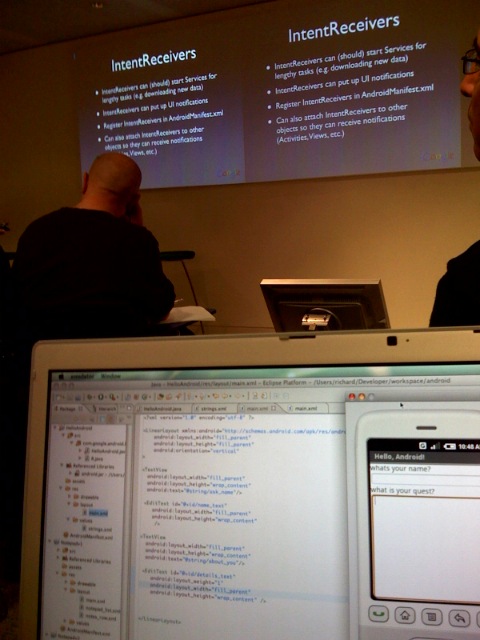
Half-day workshops are great: you get away from distractions; get to ask questions and get quick answers to cover off those things that are bugging you; you’re more-or-less forced to spend more time hands-on with a technology; you get a sense of the buzz around something and which bits are good and bad; and… it’s only half a day gone if it doesn’t turn out that way. For those and other reasons I attended the Android Developer Workshop at Google London on 17th December 2007, hosted by Dick Wall. It did a fine job of highlighting the current state of Android and which areas are the important ones to focus on.
The first thing that’s very clear: you can get a lot done in Android in not a lot of code.
If you’re a Mac user the other thing you notice is that you can develop on a Mac without jumping through hoops. It’s almost like Google are treating the Mac as a first class citizen, and I can’t tell you how convenient and wonderful that is.
I’ve been playing around with some of the APIs and finding it all well documented already, and quite fun. For my own reference, useful pages include: the optional APIs home page, the glossary, the class index, the application lifecycle, and the activity lifecycle.
It’s new, so there are gaps in the documentation. For example, when
putting together an LBS application, you discover that the emulator
supports mock data sources, but you need to dig around the mailing list
to find out how to register them. Say you have a KML file you want to
use as a location provider called “brighton”. Call the file “kml” then
load that into the emulator from your shell with:
$ adb push kml /data/misc/location/brighton/kml and then restart the
emulator.
There’s a lot that’s not done yet or not figured out. One nice idea is that there may be support for an XMPP-like server push. That is, your Android app can listen out for server-generated Jabber-ish messages and do something. How will that work in practice across the networks? How will mobile clients be looked up and discovered? We can guess at these things, but we don’t yet know the answers.
So, early days. For now we only have emulators, so we won’t get much of a feel for how this will all pan out until there are at least a couple of handsets out there. But it’s powerful, well thought-out stuff. If you’re thinking about this space, I’d say it’s at least worth spending a day working through the tutorial application.
The event was recorded so I’d expect the video to show up somewhere on YouTube one day.